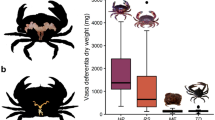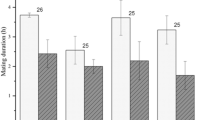Abstract
Menida scotti (Puton) males have been shown to transfer secretions from their bulbus ejaculatorius and reservoir of ectodermal accessory gland to females by mating during hibernation. In the present study, the major components of the secretions were found to be proteins and lipids. To specify the female organ incorporating the male secretions, a radiotracer experiment in which the male secretions were labeled by [14C]valine was conducted in nine tissues of females collected in the fall and spring of the hibernation period. Relatively high radioactivities were detected in the haemolymph and the residual carcass (head, legs, air-sacs, exoskeleton, etc.) in the fall females, and in CO2 gas evolved and carcasses in the spring females. The radioactivities in the fat body were significantly higher in the fall mating females than in the spring mating females, and vice versa in the ovary. The radioactivities in six fractions (lipids, proteins, glycogen, sugars, free amino acids and the residues) were also assayed in the five organs of females that had a relatively high radioactivity. The highest radioactivity was detected in the protein fraction of the haemolymph in fall and spring females. There were significant differences in the radioactivities incorporated into the lipid fractions of the carcass between fall and spring females.
Similar content being viewed by others
References
Boggs, C. L. (1990) A general model of the role of male-donated nutrients in female insects' reproduction.American Naturalist 136: 598–617.
Boggs, C. L. and L. E. Gilbert (1979) Male contribution to egg production in butterflies: evidence for transfer of nutrients at mating.Science 206: 83–84.
Boucher, L. and J. Huignard (1987) Transfer of male secretions from the spermatophore to the female insect inCaryedon serratus (OL.): analysis of the possible trophic role of these secretions.Journal of Insect Physiology 33: 949–957.
Bownes, M. and L. Partridge (1987) Transfer of molecules from ejaculate to female inDrosophila melanogaster andDrosophila pseudoobscura.Journal of Insect Physiology 33: 941–947.
Bursell, E. (1970)An introduction to insect physiology. Academic Press, London.
Chen, P. S. (1984) The functional morphology and biochemistry of insect male accessory glands and their secretions.Annual Review of Entomology 29: 233–55.
Florkin, M. and C. Jeuniaux (1974) Hemolymph: composition. pp. 256–308.In M. Rockstein (ed.)The physiology of insecta 5. Academic Press, New York.
Fox, C. W. (1993) Multiple mating, lifetime fecundity and female mortality of the bruchid beetle,Callosobruchus maculatus (Coleoptera: Bruchidae).Functional Ecology 7: 203–208.
Friedel, T. and C. Gillott (1976) Male accessory gland substance ofMelanoplus sanguinipes: an oviposition stimulant under the control of the corpus allatum.Journal of Insect Physiology 22: 489–495.
Friedel, T. and C. Gillott (1977) Contribution of male-produced proteins to vitellogenesis inMelanoplus sanguinipes.Journal of Insect Physiology 23: 145–151.
Gwynne, D. T. (1984) Courtship feeding increase female reproductive success in bushcrickets.Nature 307: 361–363.
Huignard, J. (1983) Transfer and fate of male secretions deposited in the spermatophore of females ofAcanthoscelides obtectus say (Coleoptera Bruchidae).Journal of Insect Physiology 29: 55–63.
Kobayashi, T. (1967) Hibernation in houses and its damages to inhabitants inMenida scotti Puton (Heteroptera: Pentatomidae).Rostria 15: 62–64. (in Japanese)
Kon, M., A. Oe and H. Numata (1993) Intra- and interspecific copulation in the two congeneric green stink bugs,Nezara antennata andN. viridula (Heteroptera, Pentatomidae), with reference to postcopulatory changes in the spermatheca.Journal of Ethology 11: 83–89.
Koshiyama, Y., H. Tsumuki, M. Muraji, K. Fujisaki and F. Nakasuji (1993) Transfer of male secretions to females through copulation inMenida scotti (Heteroptera: Pentatomidae).Applied Entomology and Zoology 28: 325–332.
Koshiyama, Y., K. Fujisaki and F. Nakasuji (1994) Mating and diapause in hibernating adults ofMenida scotti Puton (Heteroptera: Pentatomidae).Researches on Population Ecology 36: 87–92.
McLain, D. K., M. B. Hancock and M. A. Hope (1990) Fitness effects of nonrandom mating in the regwort seed bug,Neacoryphus bicrucis (Hemiptera Lygaeidae).Ethology Ecology & Evolution 2: 253–262.
McLain, D. K. and N. B. Marsh (1990) Male copulatory success: heritability and relationship to mate fecundity in the southern green stinkbug,Nezara viridula (Hemiptera: Pentatomidae).Heredity 64: 161–167.
Pendergrast, J. G. (1956) The male reproductive organs ofNezara viridula (L.) with a preliminary account of their development (Heteroptera; pentatomidae).Transactions of Royal Society of New Zealand 84: 139–146.
Scott, D. (1986) Inhibitation of femaleDrosophila melanogaster remating by a seminal fluid protein (esterase 6).Evolution 40: 1084–1091.
Tauber, M. J., C. A. Tauber and S. Masaki (1986)Seasonal adaptations of insects. Oxford Univ. Press, New York.
Thornhill, R. and J. Alcock (1983)The evolution of insect mating systems. Harvard Univ. Press, Cambridge.
Tsumuki, H. and K. Kanehisa (1980) Metabolism of14C-glucose and UDP-14C-G in hibernating larvae of the rice stem borer,Chilo suppressalis Walker.Berichte des Ôhara Institus für Landwirtshaftliche Biologie Okayama Universität 18: 43–53.
Tsumuki, H., R. R. Rojas, K. B. Storey and J. G. Baust (1987) The fate of [14C]glucose during cold-hardening inEurosta solidaginis (Fitch).Insect Biochemistry 17: 347–352.
Watanabe, M. (1988) Multiple matings increase the fecundity of the yellow swallowtail butterfly,Papilio xuthus L., in summer generations.Journal of Insect Behavior 1: 17–29.
Yamashita, O. and K. Hasagawa (1964) Studies on the mode of action of the diapause hormone in the silkworm,Bombyx mori L. (IV) Effect of diapause hormone on the glycogen content in ovaries and the blood sugar level of silkworm pupae.Journal of Sericultural Science, Japan 33: 407–416.
Yamaya, T., D. Rhodes and H. Matumoto (1986) Synthesis of [15N]Glutamate from [15N]H4 + and [15N]Glycine by mitochondria isolated from pea and corn shoots.Plant Physiology 81: 754–757.
Author information
Authors and Affiliations
Rights and permissions
About this article
Cite this article
Koshiyama, Y., Tsumuki, H., Fujisaki, K. et al. Nutritional contribution to females of14C-labeled male secretions transferred during mating inMenida scotti (Heteroptera: Pentatomidae). Res Popul Ecol 38, 51–56 (1996). https://doi.org/10.1007/BF02514970
Received:
Accepted:
Issue Date:
DOI: https://doi.org/10.1007/BF02514970




